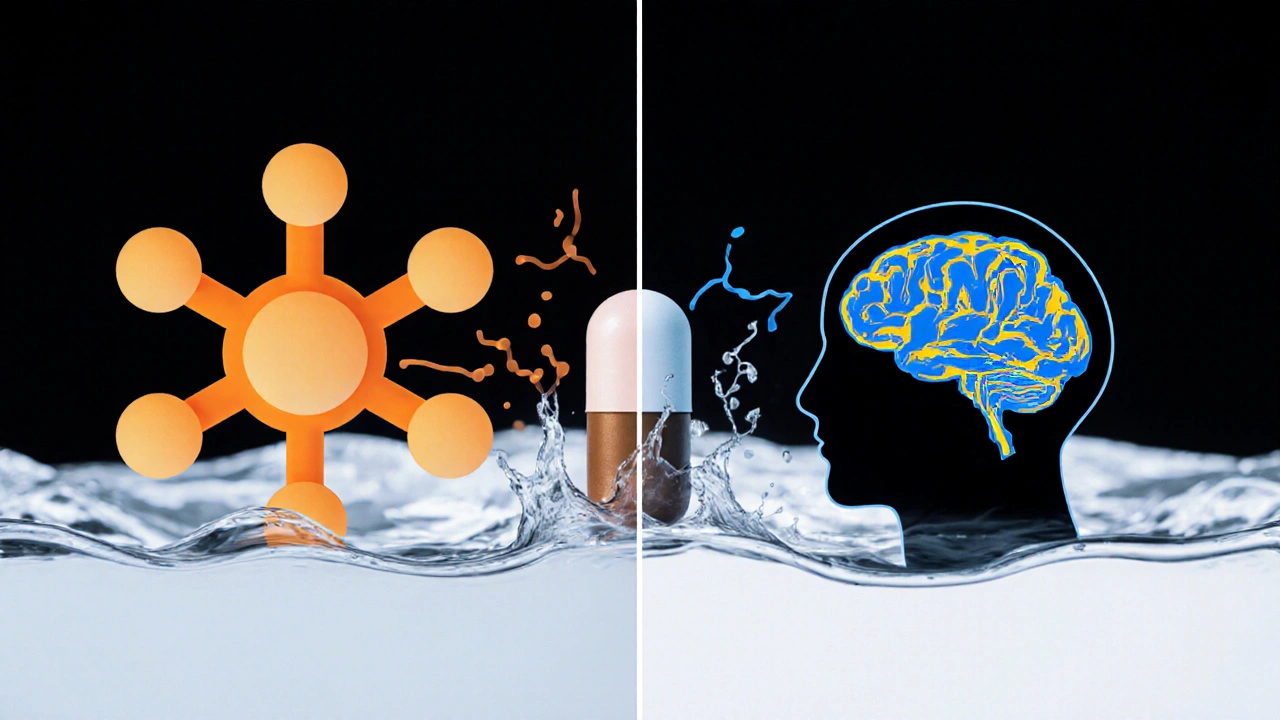Anacin vs. Popular Over‑The‑Counter Pain Relievers: A Detailed Comparison
 Oct, 8 2025
Oct, 8 2025
Anacin vs. OTC Pain Relievers Comparison Tool
Quick Comparison Summary
This tool helps you compare Anacin with other common OTC pain relievers to determine which might best suit your needs based on ingredients, onset time, duration, and side effects.
Recommended Pain Reliever
Detailed Comparison Table
| Product | Ingredients | Caffeine | Onset Time | Duration | Cost per Tablet | Side Effects |
|---|
Looking for a quick fix when a headache or minor muscle ache strikes? You’ve probably seen Anacin alternatives pop up in pharmacy aisles, but how does Anacin actually stack up against the crowd? This guide walks through the science, the side‑effects, and the price points so you can decide whether Anacin is the right pick or if another OTC option fits better.
Key Takeaways
- Anacin combines aspirin (325mg) with caffeine (65mg) for fast pain relief and increased alertness.
- Alternatives like Excedrin, Advil, Tylenol, Aleve, and plain ibuprofen differ in active ingredients, caffeine content, and duration of action.
- Choose Anacin if you need rapid onset and can tolerate caffeine; avoid it if you have stomach ulcers or are caffeine‑sensitive.
- Cost and dosing frequency often tip the balance - many alternatives are cheaper and need fewer tablets per day.
- Always check interactions with other meds, especially blood thinners or anxiety drugs.
What Is Anacin?
Anacin is an over‑the‑counter analgesic that pairs aspirin (a salicylate) with caffeine. First marketed in the 1930s, the blend was designed to boost the pain‑relieving power of aspirin while counteracting the drowsiness it can cause.
How Anacin Works
The aspirin component blocks cyclooxygenase enzymes (COX‑1 and COX‑2), which reduces prostaglandin production and eases inflammation. Meanwhile, caffeine narrows blood vessels in the brain and stimulates the central nervous system, sharpening focus and speeding up the onset of relief. This dual action makes Anacin a go‑to for tension‑type headaches, migraine aura, and minor aches where you can’t afford to feel groggy.

Popular Alternatives
Below are the most common OTC contenders, each with its own mix of active ingredients and caffeine levels.
- Excedrin combines acetaminophen, aspirin, and caffeine.
- Advil contains ibuprofen as its sole active ingredient.
- Tylenol is pure acetaminophen.
- Aleve offers naproxen sodium for longer‑lasting relief.
- Ibuprofen (generic) provides the same NSAID effect as Advil but often at a lower price.
Side‑Effect Profile
All NSAIDs (aspirin, ibuprofen, naproxen) can irritate the stomach lining, especially when taken without food. Caffeine adds jitteriness, insomnia, or increased heart rate for sensitive users. Acetaminophen is gentler on the stomach but poses liver risk at high doses. Below is a quick glance:
- Aspirin + caffeine (Anacin): stomach upset, possible increased bleeding risk, caffeine‑related insomnia.
- Pure ibuprofen (Advil/Ibuprofen): mild GI irritation, rare kidney concerns.
- Acetaminophen (Tylenol): minimal GI impact, liver toxicity if exceeding 4g/day.
- Naproxen (Aleve): longer GI exposure, but only one dose needed for 8‑12h relief.
- Excedrin (combo): similar to Anacin but adds acetaminophen, raising liver concerns when combined with other acetaminophen products.
Comparison Table
| Product | Active Ingredient(s) | Caffeine (mg) | Typical Use | Onset | Duration | Cost (US$ per tablet) | Key Side‑Effects |
|---|---|---|---|---|---|---|---|
| Anacin | Aspirin 325mg + Caffeine 65mg | 65 | Headache, minor muscle pain | 5‑10min | 4‑6h | 0.25 | Stomach irritation, insomnia |
| Excedrin | Aspirin 250mg + Acetaminophen 250mg + Caffeine 65mg | 65 | Migraine, tension headache | 5‑15min | 4‑6h | 0.30 | GI upset, liver strain |
| Advil / Ibuprofen | Ibuprofen 200mg | 0 | Headache, inflammation, dental pain | 15‑30min | 6‑8h | 0.20 | Stomach irritation, kidney impact |
| Tylenol | Acetaminophen 500mg | 0 | Fever, mild‑to‑moderate pain | 30‑60min | 4‑6h | 0.15 | Liver toxicity (high dose) |
| Aleve | Naproxen sodium 220mg | 0 | Back pain, arthritis, menstrual cramps | 30‑45min | 8‑12h | 0.35 | Longer GI exposure, possible cardiovascular risk |

When to Choose Anacin
If you need a fast‑acting solution and you don’t mind a caffeine boost, Anacin often feels sharper than plain aspirin or ibuprofen. It shines for:
- Morning migraines when staying awake is critical.
- Work‑related tension headaches where a quick return to focus matters.
- Situations where you’re already consuming caffeine, so an extra 65mg isn’t a deal‑breaker.
Conversely, avoid Anacin if you:
- Have a history of peptic ulcers or gastritis.
- Take blood thinners (e.g., warfarin) - aspirin can increase bleeding risk.
- Are sensitive to caffeine (insomnia, anxiety, rapid heart rate).
Pros and Cons Checklist
- Pros
- Rapid onset (5‑10min) thanks to caffeine.
- Effective for both pain and fatigue.
- Widely available, inexpensive.
- Cons
- Can irritate stomach lining.
- May interfere with sleep if taken late afternoon.
- Not ideal for people on anticoagulants.
Safe‑Use Tips
- Take with a full glass of water and food to protect the stomach.
- Limit to two tablets (650mg aspirin) per 24hours unless directed by a doctor.
- Avoid mixing with other caffeine sources (energy drinks, coffee) if you’re sensitive.
- Check label warnings for interactions with blood thinners, antidepressants, or asthma inhalers.
- If pain persists beyond 24hours, seek medical advice rather than stacking more doses.
Frequently Asked Questions
Can I take Anacin with coffee?
Yes, but be aware you’ll be adding roughly 65mg of caffeine per tablet. If you’re already drinking several cups of coffee, the total caffeine may push you into jitteriness or affect sleep.
Is Anacin safe for children?
No. Aspirin is linked to Reye’s syndrome in children and teenagers recovering from viral infections. Safer pediatric options include acetaminophen or ibuprofen, following proper dosing guidelines.
How does Anacin compare to Excedrin for migraines?
Both contain aspirin and caffeine, but Excedrin adds acetaminophen, which can increase liver load. For occasional migraines, Anacin may be sufficient and less risky for the liver. If you need stronger relief and have no liver concerns, Excedrin might work better.
What should I do if I miss a dose?
Anacin is taken as needed, not on a strict schedule. If you miss a dose, simply wait until the next pain episode. Do not double up to “make up” for the missed tablet.
Are there natural alternatives to Anacin?
Herbal options like ginger tea, magnesium supplements, or a cold compress can ease mild headaches without medication. They lack the rapid pharmacologic punch of Anacin but avoid GI irritation and caffeine side‑effects.
Ida Sakina
October 8, 2025 AT 12:56It is incumbent upon every responsible adult to examine the ethical ramifications of ingesting substances that simultaneously stimulate and jeopardize the body. The combination of aspirin and caffeine in Anacin presents a paradox of relief and risk. Those who disregard the potential for gastric erosion act with reckless abandon. One must prioritize the sanctity of the digestive tract above fleeting moments of alertness. In the grand tapestry of health, prudence must prevail.
Amreesh Tyagi
October 8, 2025 AT 14:03Everyone hails Anacin as a miracle but the truth is it’s just overpriced caffeine with a side of aspirin and you’re better off with plain ibuprofen.
Brianna Valido
October 8, 2025 AT 15:26Hey folks 😊 if you need a quick pick‑me‑up Anacin can be your friend 🌟 just remember to pair it with water and maybe a snack 🍎
Caitlin Downing
October 8, 2025 AT 16:50I get the vibe that Anacin feels like a lightning bolt in your head, but teh stomach can scream if you’re not careful. It’s a neat blend of aspirin’s bite and caffeine’s zip, yet the combo can be a double‑edged sword. For some, it’s a lifesaver; for others, it’s a nasty surprise. So weigh the pros and cons before you pop a tablet.
Robert Jaskowiak
October 8, 2025 AT 18:13Oh great another “miracle pill” that promises fast relief. Because what we really needed was more caffeine in our medication cabinet, right? If you enjoy the jittery after‑effects of a triple espresso, go ahead. Otherwise, maybe stick with something that won’t keep you up at 2 am.
Julia Gonchar
October 8, 2025 AT 19:36When evaluating Anacin against other over‑the‑counter options, the first factor to consider is the pharmacological composition. Anacin pairs 325 mg of aspirin with 65 mg of caffeine, a synergy that accelerates analgesic onset. In contrast, Advil delivers only ibuprofen, which lacks a stimulant component, resulting in a slower perceptible effect. Excedrin adds acetaminophen to the mix, thereby increasing hepatotoxic risk if combined with other acetaminophen‑containing products. Tylenol, composed solely of acetaminophen, avoids gastric irritation but can burden the liver at high doses. Aleve’s naproxen sodium provides the longest duration of relief, typically eight to twelve hours, but also carries a prolonged gastrointestinal exposure. Cost per tablet varies, with Anacin averaging $0.25, while Aleve can reach $0.35, making budget a tangible concern. Onset times differ markedly; caffeine‑enhanced formulas such as Anacin and Excedrin begin working within five to ten minutes, whereas ibuprofen‑based products may require fifteen to thirty minutes. Duration follows a similar pattern, with naproxen outlasting the others, and aspirin‑caffeine combinations lasting four to six hours. Side‑effect profiles are pivotal: aspirin can increase bleeding risk, especially for patients on anticoagulants, and caffeine can provoke insomnia in sensitive individuals. Ibuprofen may affect renal function in dehydrated patients, and acetaminophen’s hepatotoxicity is dose‑dependent. For individuals with a history of peptic ulcer disease, avoiding aspirin‑containing agents like Anacin is advisable. Conversely, those who tolerate caffeine well may appreciate the rapid relief Anacin offers. Ultimately, the optimal choice hinges on personal health status, cost considerations, and the specific pain condition being treated. Consulting a healthcare professional can provide personalized guidance beyond these general comparisons.
Annie Crumbaugh
October 8, 2025 AT 21:00Looks like Anacin works fast but can mess with your stomach if you’re not careful.
Vic Harry
October 8, 2025 AT 22:23Americans should stick to home‑grown pain relief and forget foreign caffeine‑laden pills.
Suman Wagle
October 8, 2025 AT 23:46One might contemplate the existential irony of seeking alertness through a pill that simultaneously threatens the very vessel that sustains consciousness, yet the modern quest for convenience often outweighs such musings. Embrace the paradox, dear reader, and let the caffeine‑infused aspirin illuminate your path, provided you heed the whispering warnings of your gut.
Neil Sheppeck
October 9, 2025 AT 01:10I hear you, Suman – the dance between mind and body can be a wild tango, and while Anacin may be that spicy salsa you need, it’s worth remembering the rhythm of moderation. Let’s keep the conversation open and supportive, sharing tips that honor both mental spark and stomach peace.